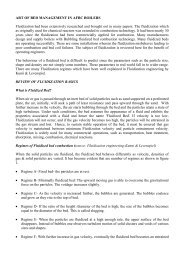Boiler Failure Due to Oversizing of Boiler feed Pump
You also want an ePaper? Increase the reach of your titles
YUMPU automatically turns print PDFs into web optimized ePapers that Google loves.
I had a look at the boiler pressure part arrangement. There were no positive downcomers <strong>to</strong> ensure the<br />
positive circulation <strong>of</strong> water <strong>to</strong> the lower drum when the water flow would be cut <strong>of</strong>f. I discussed with<br />
the Plant in charge. I explained that the boiler <strong>feed</strong> pump is oversized. The <strong>feed</strong> control valve design<br />
pressure drop seemed small and hence the <strong>feed</strong> control valve was working as on / <strong>of</strong>f valve instead <strong>of</strong><br />
regulating the <strong>feed</strong> flow.<br />
I explained that the heat pick up in the boiler was expected <strong>to</strong> be more as there was economiser and<br />
airheater down the flue gas path. <strong>Due</strong> <strong>to</strong> this, the rear set <strong>of</strong> bank tubes which are <strong>to</strong> act as<br />
downcomers suffer reverse flow. When cold water is not added <strong>to</strong> the drum, the water level appears<br />
swollen. Since the drum level remains increased for more time until the water hold up in the<br />
evapora<strong>to</strong>r comes down due <strong>to</strong> continued steam drawal. I explained the possibility <strong>of</strong> excess steaming<br />
<strong>of</strong> bank tubes due <strong>to</strong> reduced circulation. The Plant in charge confirmed that some tubes were found<br />
dis<strong>to</strong>rted inside the boiler bank. Then I recommended that the <strong>feed</strong> pump mo<strong>to</strong>r is provided with the<br />
Variable frequency drive. Alternately the control valve should be changed <strong>to</strong> suit the available excess<br />
head at the discharge <strong>of</strong> the pump. We discussed the possibility <strong>of</strong> killing the excess pressure drop by<br />
means <strong>of</strong> series <strong>of</strong> orifice plates. I gave a sketch and left the plant.<br />
THREE MONTHS LATER<br />
The Plant in Charge called up over phone <strong>to</strong> inform me that the whole boiler tubes were found <strong>to</strong> be<br />
dis<strong>to</strong>rted. The crushing season was over and the boiler was in open for cleaning. No measures were<br />
taken during the season <strong>to</strong> attend the water flow fluctuation.<br />
The steam generating tubes in the furnace were found completely dis<strong>to</strong>rted. There was mild swelling<br />
<strong>of</strong> tubes in several places. Since the tubes were tied <strong>to</strong>gether at the level <strong>of</strong> buckstays, in all other<br />
locations the tubes were found elongated and dis<strong>to</strong>rted. It was clear that the inside the tubes nucleate<br />
boiling would have been disrupted. Steam blanketing must have occurred leading <strong>to</strong> overheating <strong>of</strong><br />
tubes and abnormal thermal expansion <strong>of</strong> the tubes. It was observed that the furnace refrac<strong>to</strong>ry walls<br />
caved inside because <strong>of</strong> the thrust from the downward expansion <strong>of</strong> the tubes. It was clear that the <strong>feed</strong><br />
water flow and drum level fluctuation must have caused the reduced flow in the steam generating<br />
tubes. During the season the boiler had run at near full load. Hence the firing rate was more. Since the<br />
furnace tubes pick up more heat at increased firing rate, the tubes had <strong>to</strong> dis<strong>to</strong>rt. Yet I had <strong>to</strong> check the<br />
circulation calculations for the heated downcomers (rear set <strong>of</strong> bank tubes). The circulation<br />
calculations confirmed that adequate velocity in the steam generating tubes.<br />
This time again the <strong>feed</strong> water recorder charts showed quite lot <strong>of</strong> hunting. I explained <strong>to</strong> client that<br />
the loss <strong>of</strong> available head for circulation must have lead <strong>to</strong> poor circulation rate and thus the DNB<br />
(Departure from nucleate boiling) must have occurred.<br />
The plant in charge decided <strong>to</strong> replace all the furnace tubes and <strong>to</strong> go in for my recommendations for<br />
VFD for boiler <strong>feed</strong> pump. The cause for the entire episode was definitely the oversizing <strong>of</strong> <strong>feed</strong><br />
pump. The plant in charge explained that in sugar mills it is a practice <strong>to</strong> go in for 130 % margin on<br />
normal head and 130 % margin on flow. It was obvious that the <strong>feed</strong> pump was oversized leading <strong>to</strong><br />
high discharge pressures at normal flow rate. The <strong>feed</strong> control valve had <strong>to</strong> operate like open / close<br />
valve because <strong>of</strong> oversizing <strong>of</strong> the boiler <strong>feed</strong> pump.<br />
4 MONTHS LATER<br />
I visited the plant <strong>to</strong> check how the VFD was working in the system. The <strong>feed</strong> control valve was<br />
disconnected from the control loop. It was kept full open. The Feed pump rpm was now controlled<br />
through VFD by the Drum level control loop. The <strong>feed</strong> flow chart indicated that the <strong>feed</strong> flow is now

















